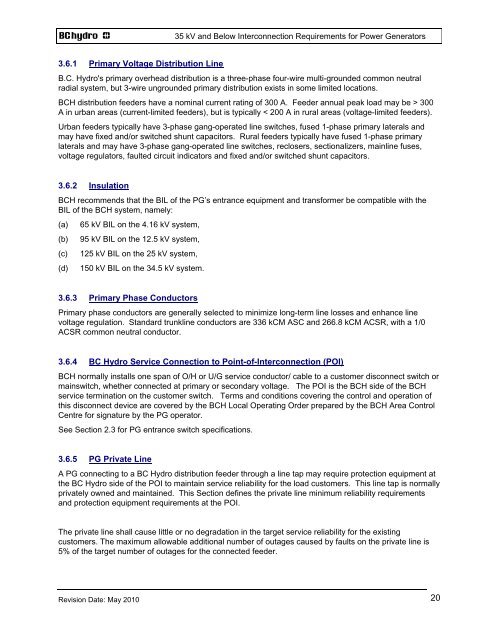35 kV and Below INTERCONNECTION REQUIREMENTS - BC Hydro
35 kV and Below INTERCONNECTION REQUIREMENTS - BC Hydro
35 kV and Below INTERCONNECTION REQUIREMENTS - BC Hydro
Create successful ePaper yourself
Turn your PDF publications into a flip-book with our unique Google optimized e-Paper software.
3.6.1 Primary Voltage Distribution Line<br />
Revision Date: May 2010<br />
<strong>35</strong> <strong>kV</strong> <strong>and</strong> <strong>Below</strong> Interconnection Requirements for Power Generators<br />
B.C. <strong>Hydro</strong>'s primary overhead distribution is a three-phase four-wire multi-grounded common neutral<br />
radial system, but 3-wire ungrounded primary distribution exists in some limited locations.<br />
<strong>BC</strong>H distribution feeders have a nominal current rating of 300 A. Feeder annual peak load may be > 300<br />
A in urban areas (current-limited feeders), but is typically < 200 A in rural areas (voltage-limited feeders).<br />
Urban feeders typically have 3-phase gang-operated line switches, fused 1-phase primary laterals <strong>and</strong><br />
may have fixed <strong>and</strong>/or switched shunt capacitors. Rural feeders typically have fused 1-phase primary<br />
laterals <strong>and</strong> may have 3-phase gang-operated line switches, reclosers, sectionalizers, mainline fuses,<br />
voltage regulators, faulted circuit indicators <strong>and</strong> fixed <strong>and</strong>/or switched shunt capacitors.<br />
3.6.2 Insulation<br />
<strong>BC</strong>H recommends that the BIL of the PG’s entrance equipment <strong>and</strong> transformer be compatible with the<br />
BIL of the <strong>BC</strong>H system, namely:<br />
(a) 65 <strong>kV</strong> BIL on the 4.16 <strong>kV</strong> system,<br />
(b) 95 <strong>kV</strong> BIL on the 12.5 <strong>kV</strong> system,<br />
(c) 125 <strong>kV</strong> BIL on the 25 <strong>kV</strong> system,<br />
(d) 150 <strong>kV</strong> BIL on the 34.5 <strong>kV</strong> system.<br />
3.6.3 Primary Phase Conductors<br />
Primary phase conductors are generally selected to minimize long-term line losses <strong>and</strong> enhance line<br />
voltage regulation. St<strong>and</strong>ard trunkline conductors are 336 kCM ASC <strong>and</strong> 266.8 kCM ACSR, with a 1/0<br />
ACSR common neutral conductor.<br />
3.6.4 <strong>BC</strong> <strong>Hydro</strong> Service Connection to Point-of-Interconnection (POI)<br />
<strong>BC</strong>H normally installs one span of O/H or U/G service conductor/ cable to a customer disconnect switch or<br />
mainswitch, whether connected at primary or secondary voltage. The POI is the <strong>BC</strong>H side of the <strong>BC</strong>H<br />
service termination on the customer switch. Terms <strong>and</strong> conditions covering the control <strong>and</strong> operation of<br />
this disconnect device are covered by the <strong>BC</strong>H Local Operating Order prepared by the <strong>BC</strong>H Area Control<br />
Centre for signature by the PG operator.<br />
See Section 2.3 for PG entrance switch specifications.<br />
3.6.5 PG Private Line<br />
A PG connecting to a <strong>BC</strong> <strong>Hydro</strong> distribution feeder through a line tap may require protection equipment at<br />
the <strong>BC</strong> <strong>Hydro</strong> side of the POI to maintain service reliability for the load customers. This line tap is normally<br />
privately owned <strong>and</strong> maintained. This Section defines the private line minimum reliability requirements<br />
<strong>and</strong> protection equipment requirements at the POI.<br />
The private line shall cause little or no degradation in the target service reliability for the existing<br />
customers. The maximum allowable additional number of outages caused by faults on the private line is<br />
5% of the target number of outages for the connected feeder.<br />
20
















